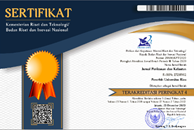The Combination Human and Cow Feces Biofertilizer to Improve the Soil and Water Quality in Pond of Pangasianodon hypophthalmus
(1) Jurusan Budidaya Perairan, Fakultas Perikanan dan Kelautan, Universitas Riau
(2) Jurusan Budidaya Perairan, Fakultas Perikanan dan Kelautan, Universitas Riau
(3) Jurusan Budidaya Perairan, Fakultas Perikanan dan Kelautan, Universitas Riau
(*) Corresponding Author
Abstract
This research was conducted from November to December 2019 at the peatland of Kualu Nenas Village, Tambang District, Kampar District, Riau Province. The purpose of this research is to get a comparison of the concentrations of human and cow biofertilizers for chemistry parameters of soil and water. The method used in this study was the experimental method of using the Complete Random Design (CRD) one factor with five treatments and three repetitions. The treatment used were P0 (Without biofertilizer), P1 (20% human feces biofertilizer + 80% cow feces biofertilizer), P2 (40% human feces biofertilizer + 60% cow feces biofertilizer) P3 (60% human feces biofertilizer + 40% cow feces biofertilizer), P4 (80% human feces biofertilizer + 20% cow feces biofertilizer). The study was using 1x1x1,4 m peat ponds which were filled with 50 fishes that were maintained for 28 days. The results of this study showed a mixture of 80% human feces biofertilizer + 20% cow feces biofertilizer provides the best solution for chemical parameters of soil and water that soil pH is 6,95, N-Total 0,3733%, P-Total 0,6073%, K-Total 0,5133%, KBOT 63,90%, and C/N 23,80 then water temperature were about 27-29 0C, water pH were about 6-7, DO were about 3,6-6,0 mg/L, CO2 were about 20,78-32,97 mg/L, water nitrate were about 0,5150-4,2134 mg/L and orthophosphate were about 1,3047-4,7463 mg/L. The growth of Pangasius (P. hypophthalmus) maintained is absolute weight is 17,33 g, absolute length is 4,433 cm, and the survival rate of Pangasius is 86%.
Keywords
Full Text:
PDFReferences
Agus, F. dan I G.M. Subiksa. 2008. Lahan Gambut: Potensi untuk pertanian dan aspek lingkungan. Balai Penelitian Tanah dan World Agroforestry Centre (ICRAF). Bogor. 36 hlm.
Balai Penelitian Tanah. 2005. Badan Penelitian dan Pengembangan Pertanian departemen Pertanian. “Analisis Kimia Tanah, Tanaman, Air, dan Pupuk”. Bogor. 136 hlm.
Damayanti, V. 2015. Kesuburan Kolam Tanah Gambut Dengan Grade Pupuk Fosfor Berbeda Ditinjau Dari Berbagai Parameter Fisika Kimia. Skripsi. Universitas Riau. Pekanbaru.
Dinata, H. S, Hasibuan, Saberina dan Syafriadiman. 2017. The Abundance of Phytoplankton in Media of Peat Soil Given Different Vermikompos. Jurnal Online Mahasiswa Fakultas Perikanan dan Kelautan, Universitas Riau Vol 4(2).
Effendie, H. 2003. Telaah Kualitas Air. Kanisius: Yogyakarta.
Fahmi, A dan B, Radjagukguk. 2015. Peran Gambut Terhadap Nitrogen Total Tanah di Lahan Rawa. Jurnal Berita Biologi, 12(2): 223-230.
Firmansyah, I. dan Sumarni, N. 2013. Pengaruh Dosis Pupuk N dan Varietas Terhadap pH Tanah, N-Total Tanah, Serapan N, dan Hasil Umbi Bawang Merah (Allium ascalonicum L.) pada Tanah Entisols-Brebes Jawa Tengah. J. Hort, 23(4):358-364.
Hasudungan, D., Sasanti, A.D, Taqwa, F.H. 2015. Pengaruh Penambahan Pupuk Hayati Cair Dengan Dosis Berbeda Terhadap Kelangsungan Hidup Benih Ikan Lele (Clarias sp.). Jurnal Akuakultur Rawa Indonesia, 3(2): 62-69.
Hubble, D S dan Harper, D M. 2000. A Received Method for Nitrate Analysis at Low Concentrations. Water Res. 34(9): 2598-2600.
Kordi K. 2009. Budi Daya Perairan. PT Citra Aditya Bakti. Bandung.
Limbong, E.O. 2017. Pengaruh Jenis Biofertilizer Terhadap Beberapa Parameter Kimia Kolam Gambut. Skripsi. Universitas Riau. Pekanbaru.
Maryam, S. 2010. Budidaya Super Intensif Ikan Nila Merah (Oreochromis sp.) dengan Teknologi Bioflok: Profil Kualitas Air, Kelangsungan Hidup dan Pertumbuhan. Skripsi. Fakultas Perikanan dan Ilmu Kelautan. Institut Pertanian Bogor, Bogor.
Noor, M. 2001. Pertanian Lahan Gambut, Potensi dan Kendala. Kanisius.
Pamungkas, R. 2014. Pengaruh Pemberian Pupuk Faeces Terhadap Perubahan Parameter Fisika-Kimia pada Media Tanah Gambut. Skripsi. Fakultas Perikanan dan Ilmu Kelautan Universitas Riau.
Peraturan Pemerintah Republik Indonesia Nomor 82. 2001. Pengelolaan Kualitas Air dan Pengendalian Pencemaran Air. Sekretaris Negara Republik Indonesia. Jakarta.
Samudra, R. P. 2018. Pengaruh Dosis Biofertilizer Formulasi dan Biomassa Azolla Microphylla Terhadap Parameter Kimia Tanah dan Air Di Kolam Gambut. Skripsi. Fakultas Perikanan dan Kelautan. Universitas Riau. Pekanbaru.
Sihite, M.A. 2020. Kelimpahan Fitoplankton dalam Kolam Gambut Ikan Patin (Pangasius hypophthalmus) yang Diberi Campuran Biofertilizer. Jurnal Online Mahasiswa Fakultas Perikanan dan Kelautan, 7(2).
Sulistyaningsih, C. R, dan Harsono, Sri. 2017. Penentuan Pemakaian Dosis dan Macam Biofertilizer dalam Pembuatan Pupuk Organik Padat Terhadap Kandungan Unsur Makro dan Analisis Finansial. Berkah Ilmiah Agribisnis AGRIDEVINA, 6(2): 191-205.
Supono. 2015. Manajemen Lingkungan untuk Akuakultur. Jakarta: Plataxia. 125 hlm.
Syafriadiman, et al. 2005. Prinsip Dasar Pengelolaan Kualitas Air. Mina Mandiri Press. Pekanbaru. 131 hlm
Article Metrics
Abstract view : 143 timesPDF - 103 times
DOI: http://dx.doi.org/10.31258/jpk.27.2.249-255
Copyright (c) 2022 Christine Natalina, Syafriadiman Syafriadiman, Saberina Hasibuan

This work is licensed under a Creative Commons Attribution-NonCommercial-NoDerivatives 4.0 International License.
Gedung Marine Center Lt 2. Fakultas Perikanan dan Kelautan Universitas Riau



